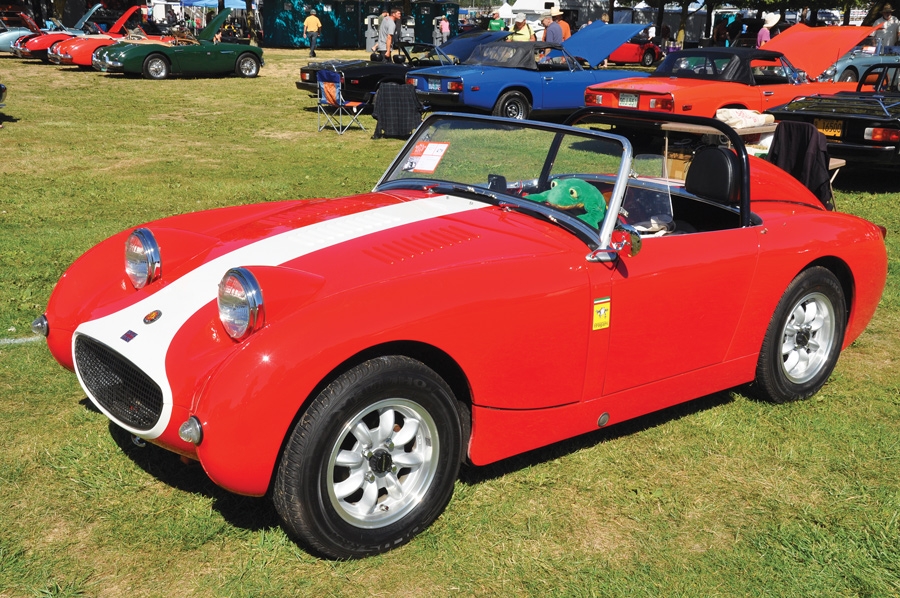
Sprite history
After a six-month lull in production, the Sprite Mark II was introduced in May 1961 — but now with a redesigned body that lost the signature headlamp pods and gained a very much more conventional shape. Retroactively known as the “Box Sprite” due to its square proportions, the first Mark II models retained the same 948-cc engine of the Bugeye, producing 46 horsepower, just three more than the original Bugeye. A total of 20,450 of these models were produced.
In October 1962, the Mark II gained a displacement increase to 1,098-cc and an additional 10 horsepower. Even more importantly, it also gained front disc brakes. These up-engined, better-braked models were known as the Mark II 1100, and 11,215 were produced.
The next model was, predictably, the Mark III. With 59 horsepower — just three more than the Mark II 1100 from a slightly modified 1,098-cc engine — the Mark III gained roll-up windows and improved weather protection. BMC made 25,905 of them.
The last exported version of the Sprite was the Mark IV, equipped with the same BMC A-series engine, but now with 1,275-cc capacity and boasting 65 hp. Don’t laugh; it’s a big step up from the original Sprite’s 43 hp, and it made a real difference. A total of 20,357 were produced from October 1966 to September 1969.
In broad-brush terms there are three general types: the Bugeye, the box Sprites with side curtains, and the box Sprites with roll-up windows. The Bugeye is in a league of its own, and the price for one reflects that. There is hardly a car that can begin to match its combination of character, simplicity, ease of maintenance and repair, and sheer driving fun.
The box Sprites are often overlooked, but they provide the same driving experience as the Bugeye, and a Mark IV with the “big” engine and disc brakes is worth serious consideration. They also sell for less than the Bugeye. They’re often a bargain and a great way to introduce youth or others on a limited budget to classic British motoring.
An identical cousin
No discussion of the Sprite would be complete without mentioning the MG Midget — the identical twin of the Mark II, Mark III and Mark IV Sprites and a car that actually outlived the Sprite by several years. Like any episode of British automotive history, there are countless nuances, rumors and theories about what happened and why, but the big picture is that the Midget Mark I was born concurrent with the Sprite Mark II and differed in almost no way except badging. Ditto the Mark II Midget and Mark III Sprite, and the Mark III Midget and Mark IV Sprite. In fact, the cars were so alike that they are still known collectively as “Spridgets” and the MG version lived on for a decade after the last Sprites were exported in 1969.
Modify at will
As they are inexpensive cars that usually need more power, most Sprites have been modified, and it is unusual to find an original, well-cared-for example. What is more common is a significantly modified Sprite that has enjoyed “inconsistent” care. However, the owners who did care about them modified them to make them even more fun.
The concept of “matching numbers” was never a consideration, and today there is no stigma attached to a Sprite with an engine from a later model. A Bugeye with a 1,275-cc engine is even more common than one with the original 948-cc version, and if a car hasn’t been retrofitted with a more powerful, later engine, the typical Sprite owner would only wonder why not.
Today, many consider the ideal Sprite to be a Bugeye with the engine and brakes from a later version. You could almost say that the best possible Sprite is a Mark IV with a Bugeye body. It’s been done. However, that is generally a little too iconoclastic even among Sprite owners, as they are a pretty individualistic group that wastes little time agonizing over micro-trivia in pursuit of concours trophies.
Therefore, your best strategy for adding one to a collection, or for starting a collection, is to seek a Bugeye with a 1,275-cc engine and disc brakes. You can actually drive it, actually keep up with all but the fastest highway traffic, and actually stop within a reasonable distance, all while provoking more smiles than a Mini Moke full of Shriners.
Sprite pitfalls are few, but the typical British car issues of the era — rust and Lucas electrics — are in full evidence with the Sprite. The large and heavy front shroud of the Bugeye can be difficult to properly fit after significant rust repair and/or a front-ender. Access to the Bugeye’s “boot” (trunk) is only though an opening behind the seats. That’s right, they have no trunk lid, so rust in the rear quadrant can be tricky to address. Additionally, the unibody construction means that rust is more than a cosmetic challenge, so a thorough, flashlight-equipped inspection for rust and hidden damage is mandatory before any purchase.
A collection starter — and keeper
Sprites are still great entry-level collector cars, and owners often find them so endearing and so fun to own and drive that the Sprite often earns a permanent place in many collections. What other car provokes so many smiles, has such a distinguished competition history, and is so inexpensive to acquire, maintain and repair? You may buy one as a collection-starter, but if you’re like most aficionados, you’ll find that it quickly earns a permanent place even as your collection grows. ♦
